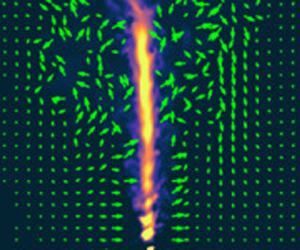Article contents
Plumes in rotating fluid and their transformation into tornados
Published online by Cambridge University Press: 05 August 2021
Abstract

Through laboratory experiments and numerical simulations, we examine the evolution of buoyant plumes as they are influenced by background rotation in a uniform density ambient fluid. The source Rossby number is sufficiently large that rotation does not directly affect the plume at early times. However, on a time scale of the order of half a rotation period, the plume becomes deflected from the vertical axis. For some experiments and simulations, the deflection persists and the flow precesses about the vertical axis. In other cases, shortly after being deflected, the plume laminarizes near the source to form a near-vertical columnar vortex, which we refer to as a ‘tornado’. Tornado formation occurs in some experiments and not in others even if the source and background rotation parameters are identical. However, their formation is more likely if the plumes are ‘lazy’. Simulations reveal that this is a consequence of the competing dynamics that occurs on comparable time scales. As a consequence of entrainment, vertical vorticity builds up within the plume reducing the Rossby number and suppressing vertical motion at distances progressively closer to the source. Meanwhile, the swirl (the ratio of the azimuthal to vertical flow) around the vicinity of the source increases, which tends to suppress three-dimensional turbulence in the near-source flow. Although the former process ultimately acts to deflect the plume off axis, in some instances, the swirl around the source succeeds in laminarizing the flow, resulting in tornado formation.
- Type
- JFM Papers
- Information
- Copyright
- © The Author(s), 2021. Published by Cambridge University Press
References
REFERENCES
- 6
- Cited by



